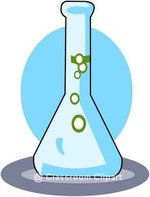Seaborgium
|
|
| |||||
| Known properties | |||||
|---|---|---|---|---|---|
| Name, Symbol, Number | seaborgium, Sg, 106 | ||||
| Chemical series | Transition metals | ||||
| Group, Period, Block | 6, 7, d | ||||
| Appearance | unknown | ||||
| Atomic weight | [266.1219] amu | ||||
| Electron configuration | probably [Rn]5f14 6d4 7s2 | ||||
| e- 's per energy level | 2, 8, 18, 32, 32, 12, 2 | ||||
| State of matter | presumably a solid | ||||
Seaborgium (Eka-Tungsten) is a chemical element in the periodic table that has the symbol Sg and atomic number 106. It was also known as "unnilhexium" (Unh), and at one time "rutherfordium" was suggested. Seaborgium is a synthetic element whose most stable isotope 266Sg has a half-life of 21 seconds. Its chemistry resembles that of tungsten.
| Contents |
History
Element 106 was discovered almost simultaneously by two different laboratories. In June 1974, a Soviet team led by G. N. Flerov at the Joint Institute for Nuclear Research at Dubna reported producing an isotope with mass number 259 and a half-life of 0.48 s, and in September 1974, an American research team led by Albert Ghiorso at the Lawrence Radiation Laboratory at the University of California, Berkeley reported creating an isotope with mass number 263 and a half-life of 1.0 s.
Because their work was independently confirmed first, the Americans suggested the name seaborgium to honor the American chemist Glenn T. Seaborg. This name was extremely controversial because Seaborg was still alive. An international committee decided in 1992 that the Berkeley and Dubna laboratories should share credit for the discovery.
An element naming controversy erupted and as a result IUPAC adopted unnilhexium (symbol Unh) as a temporary name for this element. In 1994 a committee of IUPAC recommended that element 106 be named rutherfordium and adopted a rule that no element can be named after a living person. This ruling was fiercely objected to by the American Chemical Society. Critics pointed out that a precedent had been set in the naming of einsteinium during Albert Einstein's life. In 1997, as part of a compromise involving elements 104 to 108, the name seaborgium for element 106 was recognized internationally.
Isotopes
There are 11 known isotopes of Seaborgium, the longest-lived isotope is 269Sg which decays through alpha decay and spontaneous fission. It has a half-life of 22 s. The shortest-lived isotope is 258Sg which decays through alpha decay and spontaneous fission. It has a half-life of 2.9 ms.
References
- Los Alamos National Laboratory - Seaborgium (http://periodic.lanl.gov/elements/106.html)
External links
- WebElements.com - Seaborgium (http://www.webelements.com/webelements/elements/text/Sg/index.html)
- EnvironmentalChemistry.com - Seaborgium (http://environmentalchemistry.com/yogi/periodic/Sg.html)


